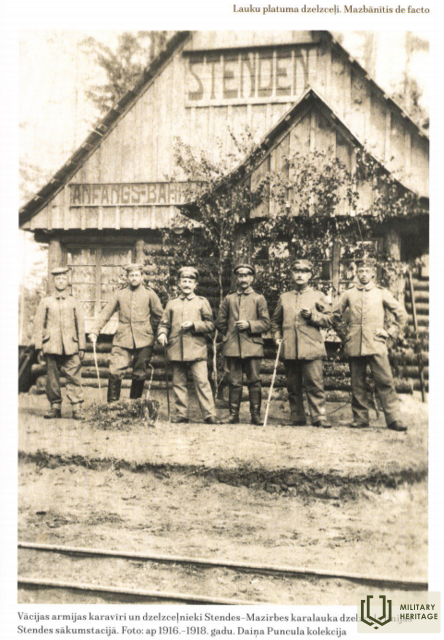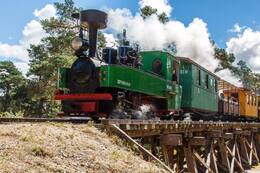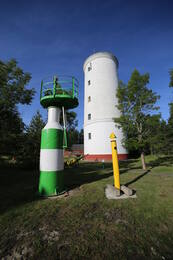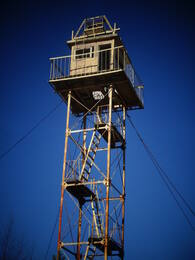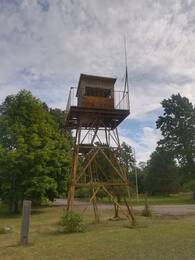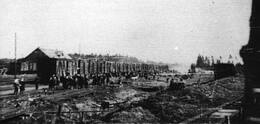Stendese jaama oluline koht kuningriigi raudteevõrgus
Kuninglike raudteede peamine ülesanne nurmkanade väina piirkonnas oli varustada Saksa armee rannikukaitsepositsioone relvade ja laskemoonaga.
Need eranditult sõjalistel eesmärkidel ehitatud kuninglikud raudteed ühendavad kolme kõige olulisemat tuletorni, mis asuvad Ovišis, Miķeļtornīs ja Šlīteres.
Raudteeliin Ventspils - Mazirbe, samuti Stende - Dundaga pikendus Mazirbe poole koos haruga Pitragi olid mõeldud ainult sõjastrateegilisteks vajadusteks. Nende liinide ehitamise ajal ja ka hiljem evakueeriti sellest piirkonnast kõik tsiviilisikud. Kuid vaatamata sellele osutati reisijatevedu ka 1. maailmasõja aastatel.
Toms Altbergs, Andris Biedriņš, Dainis Punculs, Artūrs Tukišs "RURAL WIDE RAILWAYS" Mazbānītis de facto
Seotud ajajoon
Seotud teemad
Seotud objektid
Kitsarööpmeline rong "Mazbānītis" Ventspilsi mereäärses vabaõhumuuseumis
Ventspilsi Mereäärses Vabaõhumuuseumis saab kitsarööpmelisel raudteel sõita veduriga Mazbānītis kahel liinil: ringliini pikkus on 1,4 km ning mäeliini pikkus on 3 km. Vedur Mazbānītis vedas aastatel 1916–1963 reisijaid ja kaupa 600 mm laiusel kitsarööpmelisel raudteel. Raudtee on Esimese maailmasõja aegne pärand, mis etendas olulist rolli Põhja-Kuramaa kultuurilises ja majanduslikus arengus, sest ühendas asulaid ja lõi töökohti.
600 mm kitsarööpmelise raudteevõrgu ehitamist alustati Esimese maailmasõja ajal, kui Saksa armee hakkas 1916. aastal okupeeritud Läti territooriumil ehitama nn Sõjaväe Väliraudteid (saksa keeles Heeresfeldbahn). Nende raudteede ehitamine käis kiiresti, neid oli lihtne lammutada ja teistele rindejoontele viia. Läti kitsarööpmelist raudteevõrku kasutati pidevalt ka Teise maailmasõja ajal. Ligi 60 aastat oli kitsarööpmelisel raudteel sõitev rong ainus kindel veok reisijate, põllumajandustoodete ja puidu transportimiseks suurematesse linnadesse nii talvel kui suvel.
Mazbānīša rada Põhja-Kurzemes
Mazbānīti on nimi, mis anti Põhja-Kurzemes rongile, mis vedas aastatel 1916–1963 reisijaid ja lasti mööda 600 mm laiuseid kitsarööpmelisi raudteed. See on sõjaajaloo pärand Esimesest maailmasõjast, mis omal ajal mängis olulist rolli kogu Põhja-Kurzeme, aga eriti Liibüa kalurikülade kultuurilises ja majanduslikus õitsengus, pakkudes ühendusi asulate vahel, pakkudes töökohti.
Loodusrada viib Mazirbest Sīkragasse mööda endise Stende - Ventspilsi kitsarööpmelise raudtee rada ehk nagu kohalikud ütlevad - Mazbānīši rada. Raudtee ehitamist alustati 1916. aastal ja see töötas kuni 1963. aastani. Kitsarööpmeline raudteeliin ühendas Ventspilsi sadamalinna Dundase rannakalurikülade ja Stande peamise raudteesõlmega, aidates sellega kaasa piirkonna majandus- ja kultuuribuumile Esimese ja Teise maailmasõja vahel.
Nõukogude Liidu ajal oli rannik "suletud tsoon", mistõttu rannakülad olid majanduslikult isoleeritud ja elanike arv vähenes, vastvalminud salaarmee rajatiste olemasolu aitas kaasa ka sellele, et eelmise sajandi kuuekümnendatel aastatel. , raudteeliiklus peatati.
Rajal on väike ring 15 km ja suur ring 19 km.
GPX kaart on saadaval siin:
https://www.kurzemesregions.lv/projekti/turisms/unigreen/dabas-takas/mazbanisa-dabas-taka/
Oviši tuletorn ja rannavalve
Oviši tuletorn asub Kuramaa rannikul Tārgale vallas Oviši külas ja on vanim tuletorn Lätis (ehitatud 1814. aastal). Oviši tuletorn on 37 m kõrge. Tuletorni konstruktsioon on kahesilindriline: selle läbimõõt on 11,5 m ning kiviseina sees on teine torn, mille läbimõõt on 3,5 m. Selliseid kahesilindrilisi tuletorne kasutati 18.–19. sajandil Euroopas ka kaitserajatistena vaenlase rünnaku vastu. Oviši tuletornimuuseumi majakavarustuse ja navigatsiooniseadmete kollektsiooni peetakse Läti majakamuuseumite kogude seast suurimaks. Sobiva ilma korral võib Oviši tuletornist näha Irbe majakat.
Teise maailmasõja lõpus paiknes Oviši tuletorni lähedal Saksa sõjaväe pataljonistaap ja 530. mereväe suurtükidiviisi 4. patarei ühes mitme õhutõrjesuurtükiga. Võimalik, et tuletorni jalamil asus raadiolokatsiooni ja infrapunakiirguse avastamise seade Donau Gerät. Hiljem asus tuletorni lähedal Nõukogude piirivalvekordon, kuid ükski nõukogudeaegne hoone ei ole tänaseni säilinud. Tuletorni territooriumil asub endiselt Oviši jaamahoone.
Mazirbe paadi kalmistu
Mazirbe, mis on ajalooliselt tuntud kui suurim Liivi keskus, on märkimisväärne Läti ranniku ainsa kalurite kalmistu poolest. See ehitati 1960. aastatel, viimased paadid toodi sinna 1976. aastal. Paadid sattusid siia nii püügipiirangute kui ka vanuse tõttu.
Tänapäeval on Mazirbes vähem kui kümme kalapaadi vrakki, kuid ajalooliselt on neid olnud palju rohkem. Paadid on maha pandud ka teistes mereäärsetes külades, kuid Mazirbe paadihauaplatsil on see tänapäeval kõige ilmsem.
Mazirbe paadikalmistu on ainus omataoline Läti rannikul.
Mazirbe piirivalve vaatlustorn
Nõukogude piirivalvekordon asus endise merekooli hoones. Selle kõrval asus piirivalve vaatlustorn, mis on hästi säilinud. Teine vaatlustorn asub merekaldal parkla juures. Vaatlustornid tuletavad meelde Nõukogude okupatsiooni aega, kui Mazirbe oli suletud piiritsoon ja tsiviilisikud tohtisid mere äärde minna vaid valgel ajal selleks ettenähtud kohtades. Piirivalve vaatlustorn on üks paremini säilinud sedasorti objekte Läti rannikul. Sinna ronimine on ohtlik.
Mazirbe merekool
Selles kompleksis asuv nõukogude piirivalve torn on üks paremini säilinud Läti rannikul. Kahjuks on hoonete seisukord kehv, kohapeal on püsside laadimis- ja mahalaadimispaik, samuti on päästetud sõiduauto ja kraavide fragmente.
Rannakaitsepost asus endises merekooli hoones. Nõukogude ajajärgul pakuti osades hoonetes majutust.
Nõukogude piirivalve teine torn asub umbes 400 m kaugusel rannast, kuid kahjuks on see lagunenud. Mazirbe paadikalmistu asub aga rannatornist mitte rohkem kui 500 m kaugusel Sīkragsi suunas.
Mälestuskivi Stende raudteejaamas
Ventspilsi-Mazirbe raudteeliin, samuti Stende-Dundaga pikendus Mazirbesse koos haruga Pitragsi, oli ette nähtud ainult strateegiliste sõjaliste vajaduste rahuldamiseks. Nende liinide ehitamise ajal ja pärast seda evakueeriti kõik tsiviilelanikud piirkonnast. Irbe väina piirkonnas asuvate sõjaliste raudteede peamine ülesanne oli Saksa armee rannikukaitsepositsioonide varustamine relvade ja laskemoonaga.
Need ainult sõjaväe kasutuses olevad sõjaväe raudteed ühendasid ka kolme kõige tähtsamat tuletorni, mis asusid Ovišis, Mikeltornis ja Šlīteres.
Sellest hoolimata korraldati juba I maailmasõja aastatel ka reisijatevedu.
Stende raudteejaamas asub mälestuskivi (1989) 1941. ja 1949. aastal küüditatud lätlastele.
30. oktoobril 1919 hõivasid Stende raudteejaama Bermonti väed. 17. novembril ründasid K. Šnēbergsi juhitud Läti sõjaväe sõdurid jaama, ajades ära vagunid relvade, sõjavarustuse ja viljaga. Nende lahingute eest pälvisid 6 sõdurit ordeni: K. Bumovskis (1891-1976), P. Strautiņš (1883-1969), R. Plotnieks (1891-1965), E. Jansons (1894-1977).




